Tuttle Pocket
Korean
Dictionary Korean-English
English-Korean Kyubyong Park  Published by Tuttle Publishing, an imprint of Periplus Editions (HK) Ltd. www.tuttlepublishing.com Copyright 2019 by Periplus Editions (HK) Ltd All rights reserved. No part of this publication may be reproduced or utilized in any form or by any means, electronic or mechanical, including photocopying, recording, or by any information storage and retrieval system, without prior written permission from the publisher. ISBN 978-1-4629-1444-9 (Previously published as ISBN 978-0-8048-4266-2) Distributed by: North America, Latin America and Europe Tuttle Publishing 364 Innovation Drive, North Clarendon, VT 05759-9436 USA. Tel: 1(802) 773-8930 Fax: 1(802) 773-6993 www.tuttlepublishing.com Asia Pacific Berkeley Books Pte. 3 Kallang Sector #04-01, Singapore 349278 Tel: (65) 6741-2178; Fax: (65) 6741-2179 www.periplus.com 24 23 22 21 20 19 6 5 4 3 2 1 1903CM Printed in China TUTTLE PUBLISHING is a registered trademark of Tuttle Publishing, a division of Periplus Editions (HK) Ltd. 3 Kallang Sector #04-01, Singapore 349278 Tel: (65) 6741-2178; Fax: (65) 6741-2179 www.periplus.com 24 23 22 21 20 19 6 5 4 3 2 1 1903CM Printed in China TUTTLE PUBLISHING is a registered trademark of Tuttle Publishing, a division of Periplus Editions (HK) Ltd.
Published by Tuttle Publishing, an imprint of Periplus Editions (HK) Ltd. www.tuttlepublishing.com Copyright 2019 by Periplus Editions (HK) Ltd All rights reserved. No part of this publication may be reproduced or utilized in any form or by any means, electronic or mechanical, including photocopying, recording, or by any information storage and retrieval system, without prior written permission from the publisher. ISBN 978-1-4629-1444-9 (Previously published as ISBN 978-0-8048-4266-2) Distributed by: North America, Latin America and Europe Tuttle Publishing 364 Innovation Drive, North Clarendon, VT 05759-9436 USA. Tel: 1(802) 773-8930 Fax: 1(802) 773-6993 www.tuttlepublishing.com Asia Pacific Berkeley Books Pte. 3 Kallang Sector #04-01, Singapore 349278 Tel: (65) 6741-2178; Fax: (65) 6741-2179 www.periplus.com 24 23 22 21 20 19 6 5 4 3 2 1 1903CM Printed in China TUTTLE PUBLISHING is a registered trademark of Tuttle Publishing, a division of Periplus Editions (HK) Ltd. 3 Kallang Sector #04-01, Singapore 349278 Tel: (65) 6741-2178; Fax: (65) 6741-2179 www.periplus.com 24 23 22 21 20 19 6 5 4 3 2 1 1903CM Printed in China TUTTLE PUBLISHING is a registered trademark of Tuttle Publishing, a division of Periplus Editions (HK) Ltd.
Sounds of Korean, Hangul, and Romanization 1 CONSONANTS
| Consonants | Romanization | Examples |
| C1 | C2 |
| Basic (Plain) | m | m | maeum = heart |
| n | n | nara = country hanguk = Korea |
| ng | ojingeo = squid |
| r | l | norae = song dal = the moon ppallae = laundry |
| b | p | binu = soap jip = house |
| d | t | daehak = college sutgarak = spoon |
| g | k | gage = store sikcho = vinegar |
| j | | saja = lion |
| s | | sajin = photo |
| Tense | pp | | ppareuda = fast |
| tt | | ttal = daughter |
| kk | | kkori = tail |
| jj | | jjigae = stew |
| ss | | ssal = rice |
| Aspirated | p | | podo = grape |
| t | | taedo = attitude |
| k | | ko = nose |
| ch | | baechu = Chinese cabbage |
| h | | hae = the sun |
Notes: Korean syllable structure is (C)V(C). For convenience, I call the consonant before the vowel C1, and the consonant after the vowel C2. In Korean, the consonant after the vowel is called batchim . The at the beginning of a syllable has no sound. It is nothing but a place holder. The at the beginning of a syllable is Romanized as r, but exceptionally if it is followed by another , it is Romanized as l.
In other words, ll should be used in place of lr. All consonantsother than the seven consonants , , , , , , and are not pronounced in Korean. Dont take this as the only seven consonants that can be used at a syllables final position. In fact all the consonants can be used at a syllables final position and even some double consonants can. However, they are pronounced as one of those seven consonants or they are simply not pronounced. Basically, the current Hangul orthography respects the root of a word rather than reflects the actual sound changes, whereas the Romanization system makes it a rule to follow the actual pronunciation.
You can see that there are no Romanized equivalents for consonants other than those seven when they come at the end of a syllable. Tense consonants involve tension in the vocal folds. Aspirated consonants are articulated with a puff of air. To check out the difference among the plain, tense, and aspirated consonants, refer to the demonstration videos in Korean for Beginners: Mastering Conversational Korean by Kyubyong Park and Henry J. Amen IV (Rutland, Vermont: Tuttle Publishing, 2010). 2 VOWELS
| Vowels | Romanization | Pronunciation | Examples |
| Monophthong | a | w a nt | ai = kid |
| ae | p e t | geuraeseo = so |
| eo | d o ne | eoreun = adult |
| e | p e t | keikeu = cake |
| o | toe/t o / | oi = cucumber |
| u | r u de | uyu = milk |
| i | k ee p | ireum = name |
| eu | p u sh | deureum = drum |
| y-Diphthong | ya | ya hoo | yagu = baseball |
| yae | ye s | yaegi = story |
| yeo | young | yeoreum = summer |
| yeo | ye s | ye = yes |
| yo | yodel/yodl/ | gyosil = classroom |
| yu | yu le | yuri = glass |
| ui | -3 | uisa = doctor |
| w-Diphthong | wa | wa nt | wang = king |
| wae | we t | wae = why |
| wo | wo rry | won = won (Korean currency) |
| we | we t | seuweteo = sweater |
| wi | wee k | wiheom = danger |
| oe | we t | oeguk = foreign country |
Notes: and were originally different in pronunciation, but the distinction has become almost obsolete.
However, this distinction is still preserved in writing, and their Romanization keeps it thus. The same logic applies to other pairs of / and // . is similar to the first vowel of English diphthong/o/. Observe the shape of your mouth before you move your jaw and lips for the second vowel. There is no English sound equivalent for . It would be helpful to understand that is from the combination of and .
This is true in terms of not only their writing, but also their pronunciation. So, try to make the sound of first, and then move to the quickly. Understanding the Format This dictionary is bidirectional. The Korean-English section comes first, and English-Korean section follows. I. KOREAN-ENGLISH SECTION  1.
1.
Headwords The Korean-English section contains more than 7,700 headwords. They cover not only single archetypal words, but also bound morphemes such as suffixes or particles, and idioms which consist of multiple words to form a new meaning. Every headword is presented with Hangul, the Korean script, and corresponding Roman letters. For the sake of alphabetical ordering, which everyone would be familiar with, Roman letters comes before Hangul. It should be noted that idioms may not follow the alphabetical order by Romanization. They appear right after their first word to show their key component clearly.
For example, the idiom ibe chimi mareuda comes after the headword ip , not between ibalso and ibenteu . Middle dots represent syllable boundaries. 2. Parts of Speech Parts of speech are marked with their conventional abbreviations in small capitals as follows.
| ADJ | adjective |
| ADV | adverb |
| AUX ADJ | auxiliary adjective |
| AUX V | auxiliary verb |
| DEP N | dependent noun |
| DET | determiner |
| IDM | idiom |
| INTERJ | interjection |
| N | noun |
| NUM | numeral |
Next page






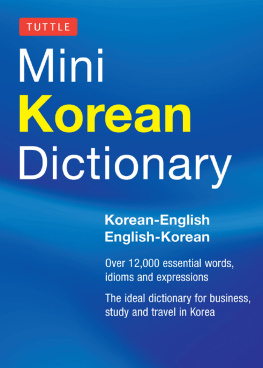
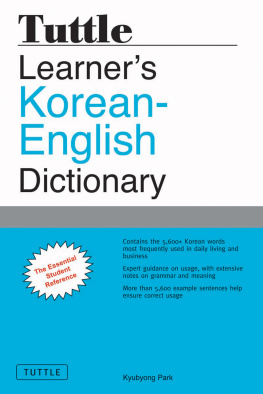


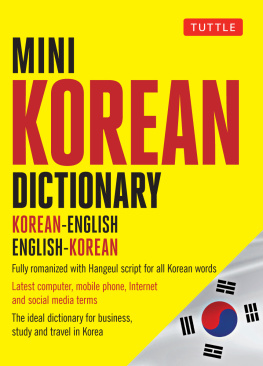

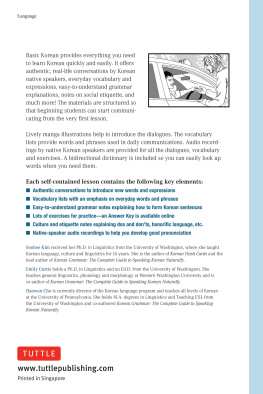
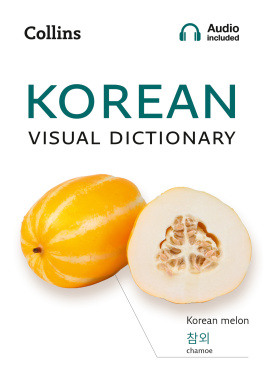




 Published by Tuttle Publishing, an imprint of Periplus Editions (HK) Ltd. www.tuttlepublishing.com Copyright 2019 by Periplus Editions (HK) Ltd All rights reserved. No part of this publication may be reproduced or utilized in any form or by any means, electronic or mechanical, including photocopying, recording, or by any information storage and retrieval system, without prior written permission from the publisher. ISBN 978-1-4629-1444-9 (Previously published as ISBN 978-0-8048-4266-2) Distributed by: North America, Latin America and Europe Tuttle Publishing 364 Innovation Drive, North Clarendon, VT 05759-9436 USA. Tel: 1(802) 773-8930 Fax: 1(802) 773-6993 www.tuttlepublishing.com Asia Pacific Berkeley Books Pte. 3 Kallang Sector #04-01, Singapore 349278 Tel: (65) 6741-2178; Fax: (65) 6741-2179 www.periplus.com 24 23 22 21 20 19 6 5 4 3 2 1 1903CM Printed in China TUTTLE PUBLISHING is a registered trademark of Tuttle Publishing, a division of Periplus Editions (HK) Ltd. 3 Kallang Sector #04-01, Singapore 349278 Tel: (65) 6741-2178; Fax: (65) 6741-2179 www.periplus.com 24 23 22 21 20 19 6 5 4 3 2 1 1903CM Printed in China TUTTLE PUBLISHING is a registered trademark of Tuttle Publishing, a division of Periplus Editions (HK) Ltd.
Published by Tuttle Publishing, an imprint of Periplus Editions (HK) Ltd. www.tuttlepublishing.com Copyright 2019 by Periplus Editions (HK) Ltd All rights reserved. No part of this publication may be reproduced or utilized in any form or by any means, electronic or mechanical, including photocopying, recording, or by any information storage and retrieval system, without prior written permission from the publisher. ISBN 978-1-4629-1444-9 (Previously published as ISBN 978-0-8048-4266-2) Distributed by: North America, Latin America and Europe Tuttle Publishing 364 Innovation Drive, North Clarendon, VT 05759-9436 USA. Tel: 1(802) 773-8930 Fax: 1(802) 773-6993 www.tuttlepublishing.com Asia Pacific Berkeley Books Pte. 3 Kallang Sector #04-01, Singapore 349278 Tel: (65) 6741-2178; Fax: (65) 6741-2179 www.periplus.com 24 23 22 21 20 19 6 5 4 3 2 1 1903CM Printed in China TUTTLE PUBLISHING is a registered trademark of Tuttle Publishing, a division of Periplus Editions (HK) Ltd. 3 Kallang Sector #04-01, Singapore 349278 Tel: (65) 6741-2178; Fax: (65) 6741-2179 www.periplus.com 24 23 22 21 20 19 6 5 4 3 2 1 1903CM Printed in China TUTTLE PUBLISHING is a registered trademark of Tuttle Publishing, a division of Periplus Editions (HK) Ltd. 1.
1.